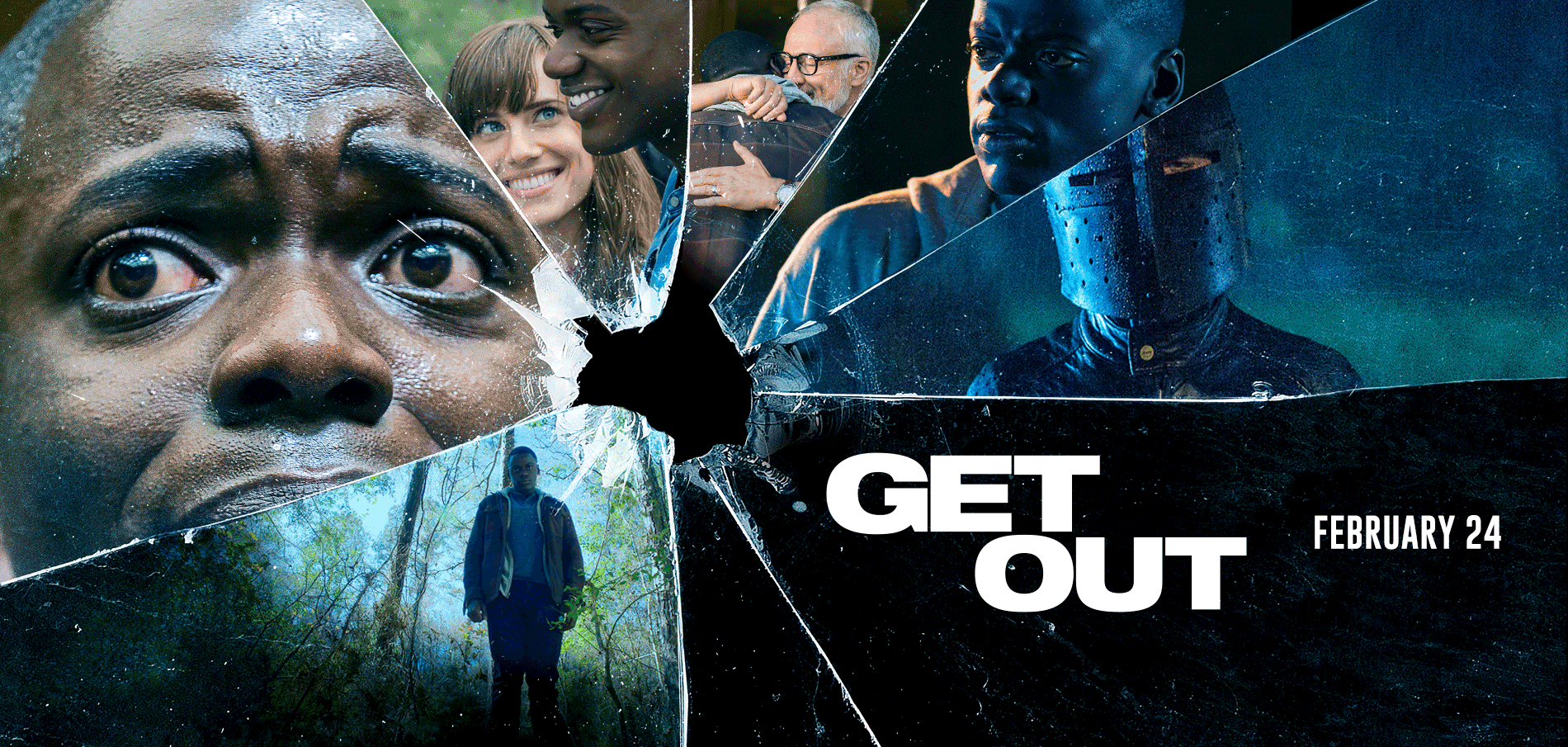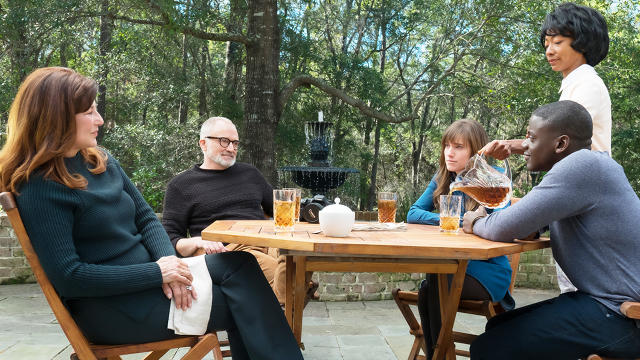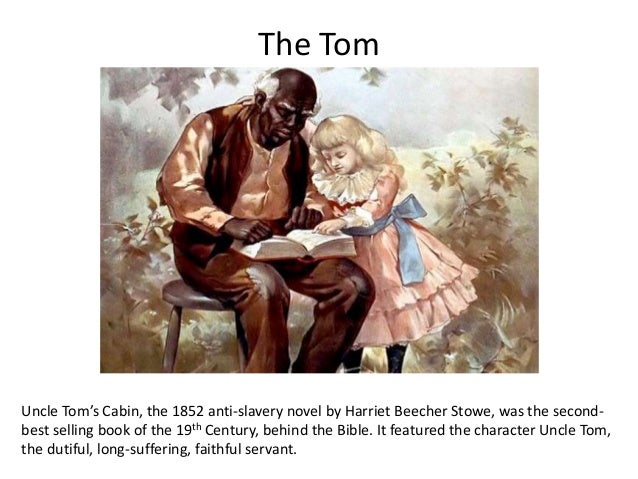
“Get Out” Analysis: Themes, Motifs, and Real-World Connections
By Shayne
Hello.
I just saw the movie Get Out last night, and have spent a lot of time since thinking really hard about it.
It was an incredibly dense experience, with subtle hints and not-so-subtle clues all over the place.
A lot of people have already pointed to the overarching themes of the film.
I’m not really here to talk about that. What I wanted to do was touch on several things I picked up, how I tied it to modern society, and what the justification was for me doing so.
Let’s get right to it:
Oh, wait–
*SUPER DUPER SPOILER ALERT*
Okay, here we go:
The Opening Scene

Usually, people are afraid of walking at night in a sketchy neighborhood.
Andre is walking in an apparently affluent neighborhood, and is still afraid.
This reflects how Black people never, ever feel completely safe in America. Because, while you can leave a bad neighborhood, we can never leave being Black.
The Deer Metaphor

I think Jordan Peele put this early in the film to serve as what school teachers would call a “gimme”.
In other words, the Deer symbolism was a placement test. Anyone who didn’t catch the blatant connection between Chris and Deer (especially after Dean’s obvious “this-is-about-Black-people” rant) probably wouldn’t get the rest of the film’s symbolism, and would instead just see the whole thing as Invasion of the Body Snatchers or some shit like that.
The use of a silver spoon as a controlling device

Missy’s bitch ass primarily used a teacup with a silver spoon to hypnotize her (typically Black) victims.
The “Silver Spoon” motif has been classically used to embody economic privilege, which the Armitage’s clearly have. The real-world connection here is a how White society has always used its economic advantages to render the Black population powerless to control its own destiny.
The entire “Hypocritical White Liberal” theme went completely over my head

A lot of writers and critics have described how Get Out is a commentary on modern Liberal Whites who are just as harmful as overt racists.
I didn’t quite catch that during my own viewing, but I know why.
Most of these critics are White, and so they’ve projected their own backgrounds and experiences into the film. They saw friends, family members, and coworkers who have all behaved like the people at the cocktail party. They probably know people who are just like the Armitages behind closed doors.
In my eyes, the things said during the cocktail party are nothing new. Much like how Chris brushed it off as another day at the office—so did I.
So yeah. I see how this theme would be communicated, but it didn’t jump out at me entirely.
That Asian Guy
Make no mistake: this wasn’t an arbitrary casting decision.
The presence of an Asian person at the cocktail party echoes the preaching of Triangulation Theory, which outlines how Asians are generally thought to be above Blacks in contemporary society while still being below White people.
His question to Chris about whether he felt more advantaged or disadvantaged being Black was also very deliberately written. The line highlights the “in between-ness” of “Model Minority” Asians in the US. The man asked Chris this question because he literally had no clue.
It seems like Jordan Peele is expressing grief of how Asian Americans sometimes criticize Black society as being a victim of its own action without stopping to realize how little they actually understand.
I think this highlights a common concern among Black people when interacting with Asians who might have an idea of Black plight in America, but lack any intimate firsthand experience of it.
Well played.
The significance of Jim Hudson’s blindness

Did you notice how Jim’s first interaction with Chris was one of immediate understanding? Me too.
Jim is fully aware of how ignorant the cocktail party attendants are, and instantly forms a bond with Chris (and the audience) by doing so.
Now, there’s a few things that I think are going on here.
First, this highlights how, when it comes to American society, a Black person will only ever be on common ground with a White person who is impaired. I think the this encounter taking place with Jim sitting by himself while surrounded by several empty chairs only makes this more likely.
Second, the scene might communicate that a White person could only ever have an understanding conversation with a Black person if they cannot see the world through privileged eyes.
Speaking of the cocktail party…

The color coordination of this entire movie was meticulously planned out. This was obvious.
However, the whole color scheme reached a crescendo (like most other elements) during the cocktail party.
Everyone arriving in a train of black cars created the ambiance that they were attending a funeral. Okay, also obvious.
Here’s what I noticed: every single attendant of the party wore a combination of Black, White, and Red—except a few.
Chris is the only character wearing blue, which makes him stand out even more than he already does.
Both Dean and Missy are wearing brown—but so is Logan/Andre, which I found particularly interesting.
“Logan” wearing brown serves as an indicator for his quasi-assimilation into White society. The significance here is that the color scheme tips us off to his Whitewashing without him ever having to say anything. Just something I picked up.
The “Fruit Loops” Deal
You’ve probably all heard this one by now.
Blah blah, separating white from coloreds, blah blah.
Moving on…
Rose’s character flip

I was able to pick this one up due to personal experience.
There’s more to Rose’s sudden character shift besides being a scheming hoe and finally showing her true face.
Her history of hunting down Black people to return home is a reflection of Black men being fetishized in modern society.
Every now and then, I encounter a White woman who only seems to view me as a sort of prize or trophy. Something to show her friends and family while saying “Look what I’ve caught!”
The real truncating here is how Rose seemed to be a well-meaning person up until the film’s third act.
The message aligns with the movie’s main theme of White people hiding classic racist beliefs behind a veil of progressivism.
The Presence of Uncle Toms

Yeah, I know that we eventually find out the servants are just the Grandparents controlling Black bodies.
But when it comes to this movie, there’s a distinction between the plot and what the plot points are supposed to represent.
The “Tom” caricature is that of a Black person who is completely eager to serve White society.

When Chris speaks to both Georgina and Walter, they both say how they are completely happy doing their duties for the Armitages with big smiles on their faces.
This isn’t just to creep us out.
After we find out that Georgina and Walter carry the consciousness of the Armitage grandparents, we are forced to face the fact that the Tom stereotype is considered the optimal fate for Blacks in America.
Happy servants who are blissful in their fate—this is what the Armitage family is working towards with their Black captives.

“Logan”/Andre represents a modern day Tom character. Today, Black people will use the “Tom” term to label another Black person as a sellout. Logan is dating a White woman, speaks in an oddly proper manner, and rejects Chris’ attempts to connect over their “Blackness”—notably his adamancy with giving Chris a handshake instead of a fist bump.
The fact that we see Andre get abducted early in the film and is subsequently Whitewashed helps bolster his status as a modern Tom.
Which leads me to…
The most poignant moment of the film

Nothing stood out to me more than a particular interaction between Chris and Georgina.
While Chris is talking to Georgina about her life at the Armitage residence, she starts shedding tears while speaking to him.
Again—the plot would suggest that the ‘actual’ Georgina is trying to escape captivity, which is communicated through the tears.
To me, this scene reflected the guilt many Black people experience when they change how they present themselves in order to fit in with White society. When a Whitewashed Black person encounters a more “typical” Black person, they can’t help but feel a sense of self-betrayal.
That’s what I saw in Georgina’s tears—a Black person who hates what they’ve become, but must continue to be that way in order to be accepted.
Alright, that about wraps up what I’ve come up with. Let me know if you have anything else you’d like to add.
Thanks for reading.


I really enjoyed reading this! Lots of things I didn’t pick up on that make sense to me now so thank you 🙂
“It seems like Jordan Peele is expressing grief of how Asian Americans sometimes criticize Black society as being a victim of its own action without stopping to realize how little they actually understand.”
“I think this highlights a common concern among Black people when interacting with Asians who might have an idea of Black plight in America, but lack any intimate firsthand experience of it.”
Wow. Way to brush over years of black-AA conflict by doing the work for white people: pitting two POC communities against one another.
Lmao.
I fell that the scene with the fruit loops isn’t about separating the whites from the colors. its to give a bit of foreshadowing to the spoon on the glass. if Rose was to eat cereal out of a glass bowl with a metal spoon, then everyone in the sunken place would snap out of their trans.